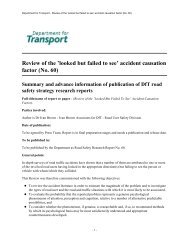Bicycle Reflector Project - Consumer Product Safety Commission
Bicycle Reflector Project - Consumer Product Safety Commission
Bicycle Reflector Project - Consumer Product Safety Commission
Create successful ePaper yourself
Turn your PDF publications into a flip-book with our unique Google optimized e-Paper software.
Treatment<br />
No.<br />
Table 3. Parallel Path Mean Detection and Recognition Distances and Standard<br />
Deviation by Treatment in Descending Order by Detection<br />
Rear Treatment<br />
Mean<br />
Detection/Standard<br />
Deviation (in feet)<br />
Mean<br />
Recognition/Standard<br />
Deviation (in feet)<br />
1 Red blinking tail light/reflector 847/36 702/36<br />
4 White pedal reflectors 786/32 706/31<br />
6 Large red rear reflector 759/36 703/36<br />
5 CPSC regulation reflectors 744/36 712/35<br />
3 Amber rear reflector 726/37 670/36<br />
2 Larger area Yellow/Green<br />
fluorescent sheeting on rear and<br />
pedals<br />
708/39 657/40<br />
When comparing treatments to the CPSC regulation reflectors, only the bicycle with the<br />
red blinking tail light/reflector was detected at a statistically significant longer distance. This<br />
treatment utilized the benefits of lights and reflectors. At long distances, the blinking light was<br />
visible before the reflector and at short distances the reflector function gave the appearance of a<br />
steady red light.<br />
CPSC staff attributes the increased detection of the blinking light/reflector over the<br />
reflector targets to the performance of the active light source. The light treatment was not<br />
dependent on the car's headlights for illumination and was visible at longer distances. The flashing<br />
of the light may have also contributed to increased detection by focusing the subjects' attention to<br />
the object and away from the background noise. Researchers have shown that flashing lights used<br />
in a background absent of flashing lights are more conspicuous than a steady light [14].<br />
While detection of this light/reflector treatment was statistically significantly different from<br />
the CPSC regulation reflector, recognition was not. Some of the subjects incorrectly identified<br />
the flashing red light as a police car, or a hazard signal; it was not until they got closer and could<br />
see more of the bicycle form that they identified it correctly. The motion of the reflective pedals<br />
was the feature most attributed to recognition of the bicycles. Many subjects commented that<br />
they recognized the up and down movement as being associated with pedals, and thus, identified<br />
the object as a bicyclist.<br />
- 15 -





